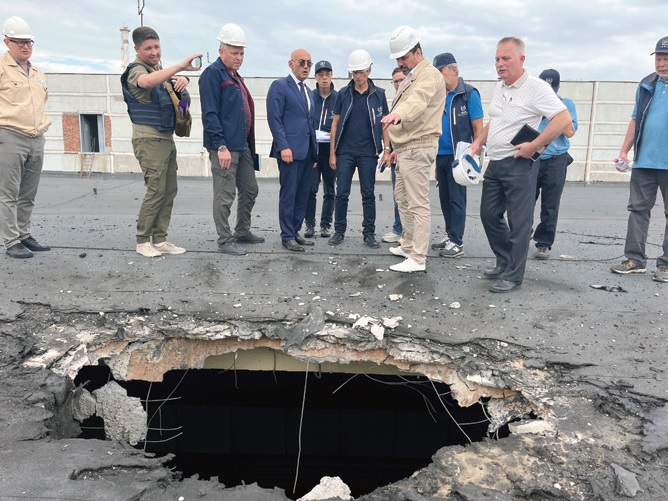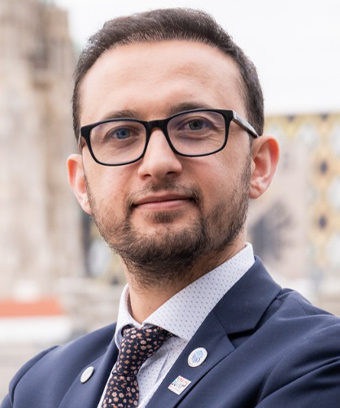Five Questions on Ensuring Nuclear Security During Conflict
In this interview, Ali Alkış, an alumnus of IGCC’s Public Policy and Nuclear Threats Boot Camp and the World Institute for Nuclear Security Ambassador to Turkey, discusses Lessons from Zaporizhzhia: How to protect reactors against ‘nuclear piracy’, an article he co-wrote with IGCC affiliate Bethany Goldblum. In the article, Alkış and Goldblum argue that the Russian occupation of the Zaporizhzhia nuclear power plant in Ukraine is distinct from nonstate nuclear terrorism, and instead constitutes something they term “nuclear piracy.”
What are the main threats that nuclear facilities and their surrounding areas face during conflict?
As we have already witnessed in Ukraine, even though the two sides haven’t directly attacked the nuclear reactors themselves, nuclear facilities have a lot of equipment and auxiliary systems, like cooling systems and power grids. If those systems are attacked, then the facilities need to rely on emergency diesel generators. If the generators are out of use or run out of diesel, there could be a reactor meltdown similar to what happened in Fukushima and Chernobyl.
Since those incidents, there have been many improvements in the safety of the reactors. In the case of Zaporizhzhia, there will be no direct meltdown because it has been reinforced. However, there’s always a risk. Besides the reactors, the facilities store used fuel. In Zaporizhzhia, the used fuel is either in cooling halls or the cascades, which are more vulnerable. If any shells hit them, there will be a huge release of radioactivity.
Based on statistical data, experts don’t expect anything in Zaporizhzhia to happen at the level of Fukushima or Chernobyl because all of the reactors are in cold shutdown, which means they are not working. However, the reactors still have uranium inside, so it will take a long time until the facility is totally non-radioactive. The problem is that there is constant armed conflict in and around the facility. When Russia attacks Ukrainian forces in the area, their shelling is not precise, so even if they’re targeting somewhere else, they might accidentally hit auxiliary systems of the facility. If Ukraine’s security forces try to take over the power plant from the Russians, there will be even more fighting in and around the facility.
Have the increased threats to the Zaporizhzhia nuclear power plant led to a shift in public perception about the safety of nuclear energy?
In this scenario, I don’t believe there is a change in public perception because there has been no radiological release. We cannot say the public has started to be afraid of nuclear energy or is reacting against it—I haven’t seen any indication at the regional, national, or global levels. But, if we do see a radiological release in Zaporizhzhia, I’m sure there will be a huge hit back on public perceptions of nuclear energy.
You define a new term, nuclear piracy, as “the illicit acquisition, manipulation, and exploitation of nuclear materials and facilities [by state actors] for strategic purposes.” What led you to develop this term? What are the consequences inherent in the notion of state actors—rather than nonstate actors—committing acts of nuclear piracy?
Nuclear terrorism involves nonstate actors, which could be criminal organizations, smugglers, or illicit traffickers looking to sell plutonium on the black market, or otherwise a terrorist organization looking to obtain nuclear materials to build nuclear weapons. We feel that people misuse the term “nuclear terrorism” in the case of Zaporizhzhia because they think that Russia sabotaged the facility. Sabotaging a nuclear facility is an act of nuclear terrorism.
[I]n the case of Zaporizhzhia, it’s more than sabotage. We’re talking about Russia, a state with nearly 6,000 nuclear weapons, taking over a nuclear power plant and operating it.
It is now under [the Rosatom State Nuclear Energy Corporation’s] jurisdiction, and there is a presidential decree that the Zaporizhzhia nuclear power plant is a Russian asset. We cannot call this nuclear terrorism—this is a new dimension.
Even though everyone knows that there are invaders onsite, no one can intervene; not the U.S., UN, or Europe. [Bethany Goldblum] and I argue in our article that, if it was a terrorist attack, it could be easier to mitigate and address, because we cannot expect a terrorist organization to take over and operate the nuclear power plant. This is something only a state can do. It’s beyond the capabilities or intentions of terrorists. In this case, it is a state actor invading another state, which violates the United Nations Charter and the principle of sovereignty.
Is the current design of the International Atomic Energy Agency (IAEA), the UN’s nuclear watchdog, equipped to prevent or mitigate state-sponsored nuclear piracy?
The problem is that this is not the first time a nuclear facility has been attacked by a state actor. There have been similar cases before, for example in Iraq, Iran, and Syria. However, in those cases, the nuclear facilities were not operational, and they were much smaller; it was just Israeli fighter jets taking off, shutting it down, and coming back, but there was no military action and no manipulation of uranium or installation of operating personnel. It was with the intent to stop proliferation and just focused on the buildings themselves, so it was thought to be outside the scope of the safeguards.
However, in the case of Zaporizhzhia, Russia operates the plant, and there is an attempt to connect it to the Russian electrical grid. If they manage to do this, it means they will fully power all six reactors to supply electricity to Russian-occupied territory in Ukraine. In this case, the potential actions for the IAEA are limited.
When we look at nuclear safeguards, the IAEA has a mandate: they can send inspectors, write reports, and even bring the issue to the UN Security Council. On nuclear security, the IAEA has limited authority, because security is something for the state government to handle, since it’s related to their sovereignty. We cannot expect the IAEA to force states to do something, since the IAEA’s traditional role has been to guide states. If a member state asks for help from the IAEA, they can send teams, write papers, and arrange workshops to guide states.

The IAEA team observes the damage caused by shelling on the roof of the special building at the ZNPP that houses, among other items, the fresh nuclear fuel and the solid radioactive waste storage facility. Photo courtesy of the IAEA.
Rafael Grossi, the Director General of the IAEA, visited Zaporizhzhia and established a permanent IAEA presence in the nuclear facilities there. He knows that the IAEA doesn’t have the authority to do much, but they made an arrangement with the Ukrainians and Russians to ensure that, when IAEA personnel are onsite, they have certain rights to report what’s going on there. However, as we’ve already witnessed, they were not given full access to every room in the facility. Even though they are onsite, their authority is limited to monitoring. The security of nuclear materials belongs to the state. It is not an international responsibility. However, as we have discussed, the consequences might spread beyond international borders. That’s the issue that forces the IAEA to go there.
What are some solutions that the international community can pursue to ensure nuclear security during conflict?
Potential solutions in Ukraine are limited because we cannot talk about an international agreement to be signed, or even discussed, during this political crisis [since] Russia will not participate in discussions. It will take a long time to finalize an international convention to prohibit armed attacks against nuclear facilities, so we cannot expect it to be concluded before the crisis ends in Ukraine.
However, what we can do in Ukraine is implement an operational solution by establishing a nuclear safety and security zone. There are two important aspects of this zone: one is a demilitarized zone (DMZ), as we can see in Cyprus and between the two Koreas. Our idea is very similar to a DMZ. However, in those zones, there is a full withdrawal of military equipment and personnel. In our suggestion, it requires the full cessation of kinetic military conflict. In this scenario, we don’t expect Russia to withdraw all of its forces, but we expect Russia and Ukraine to agree to not attack from or to nuclear facilities. This will protect us from a human-made nuclear incident. Ukrainians will likely accept it because their population is the most at risk in the event of radiological release, as are other European states. Russians also have an incentive to agree, because radiological release works based on the wind—if Russia causes radiological release, it could also go into Russian-occupied areas of Ukraine or Russia itself. In this case, we believe Russia would also benefit from the DMZ, and would just need to cease any shelling in the vicinity of the facilities.
Going back to the idea of an international convention, I’d like to emphasize that we need norms. If we have international norms, we can hold states accountable. This also shows how the situation is different from an occupation by nonstate actors—you cannot hold nonstate actors accountable. However, in the case of Zaporizhzhia, if we have a norm not to attack nuclear facilities, we can hold states accountable after the crisis ends. It happened during World War II; the 1928 Kellogg-Briand Pact outlawed war as a means to solve problems between states. If we didn’t have this pact, there wouldn’t have been a way to have the Nuremberg or Tokyo trials and hold Nazi Germany and Imperial Japan accountable for the crimes they committed.
Ali Alkış is the World Institute for Nuclear Security Ambassador to Turkey and a Ph.D. candidate at Hacettepe University in Ankara. Bethany Goldblum is associate professor in the Nuclear Engineering Department at UC Berkeley and faculty scientist in the Nuclear Science Division at Lawrence Berkeley National Laboratory.

Global Policy At A Glance
Global Policy At A Glance is IGCC’s blog, which brings research from our network of scholars to engaged audiences outside of academia.
Read More